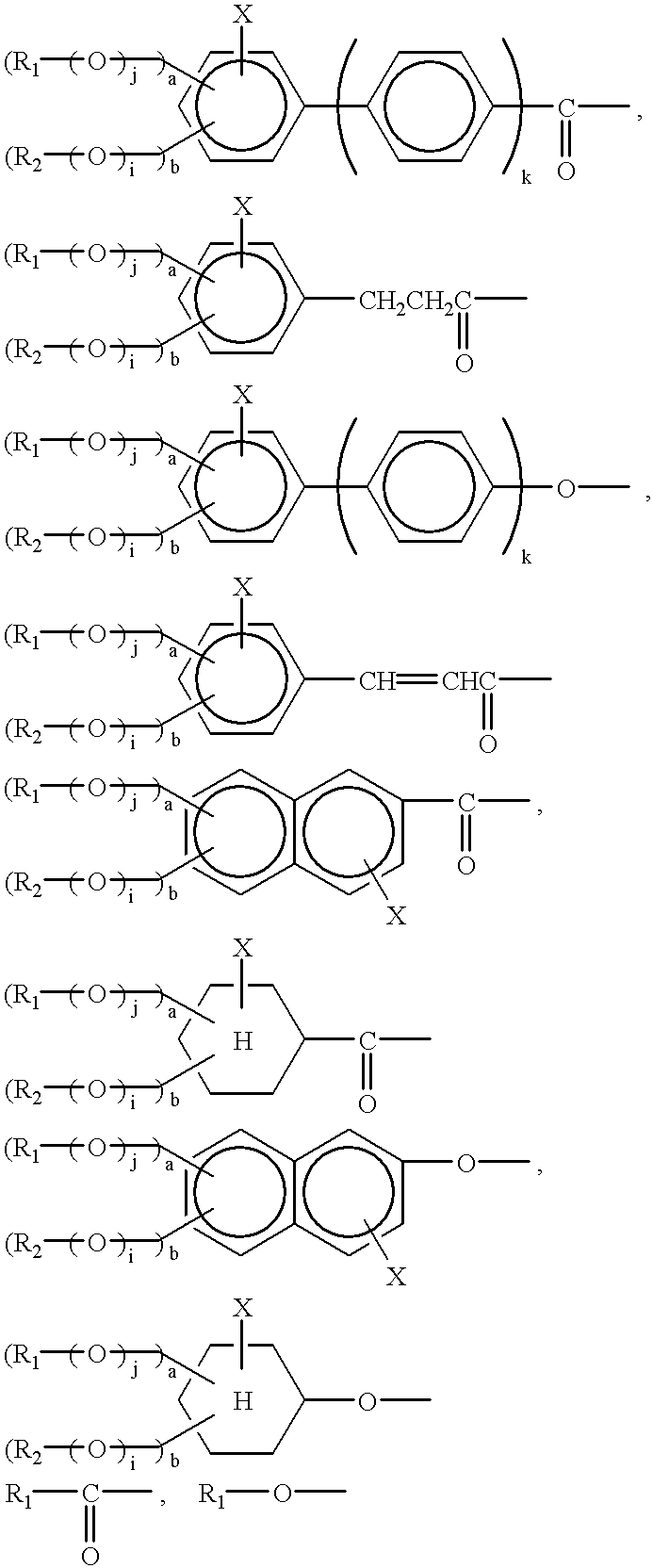Optical film
a technology of optical film and polarizing element, applied in the field of optical film, can solve the problems of widened visual field to such an extent that is unattainable, and achieve the effect of improving enhancing the angle of visual field, and effective color compensation
- Summary
- Abstract
- Description
- Claims
- Application Information
AI Technical Summary
Benefits of technology
Problems solved by technology
Method used
Image
Examples
example 1
A mixture of 10 mmol of 4-n-hexylbenzoic acid, 95 mmol of terephthalic acid, 50 mmol of hydroquinone diacetate, 50 mmol of 3-methylcatecol diacetate and 100 mg of sodium acetate was polymerized for 12 hours at 270.degree. C. in a nitrogen atmosphere. The reaction product obtained was dissolved in tetrachloroethane and the resulting solution was combined with methanol to purify the product by way of precipitation. In this way, 22.0 g of a liquid crystalline polyester (formula (1)) was obtained. This liquid crystalline polyester had a logarithmic viscosity of 0.15, a nematic phase as a liquid crystal phase, an isotropic-liquid crystal phase transition temperature of 240.degree. C. and a glass transition temperature of 75.degree. C.
A 10 wt % solution of this liquid crystalline polymer in a solvent mixture of phenol / tetrachloroethane (6 / 4 by weight) was then prepared. The solution was bar-coated on a sheet of soda glass. After being dried, the coating was heat-treated at 190.degree. C. ...
example 2
As in Example 1, a liquid crystalline polyester having the formula (2) was synthesized. The liquid crystalline polyester obtained had a logarithmic viscosity of 0.16, a nematic phase as a liquid crystal phase, an isotropic-liquid crystal phase transition temperature of 220.degree. C. and a glass transition temperature of 100.degree. C. After the same examination of orientation as in Example, 1 the liquid crystalline polyester was found to have a homeotropic orientation and to have a positive uniaxiality and to have a homeotropic orientation.
Then, a 7 wt % solution of the liquid crystalline polymer having the formula (2) in chloroform was prepared. The solution was spin-coated on a rubbing-treated polyimide film overlying a sheet of glass. After being dried, the coating was heat-treated at 250.degree. C. for 30 minutes, and cooled to be immobilized. The film on the substrate was transparent, free from defect in orientation and uniform, and had a film thickness of 0.40 .mu.m and an av...
example 3
Liquid crystalline polyesters having, respectively, the structure of formula (3) and the structure of formula (4) were synthesized. The liquid crystalline polyester of formula (3) had a logarithmic viscosity of 0.12, a nematic phase as a liquid crystal phase, an isotropic-liquid crystal phase transition temperature of 200.degree. C. and a glass transition temperature of 90.degree. C. The orientation was examined as in Example 1, and the liquid crystalline polyester of formula (3) was found to have a homeotropic orientation and to have a positive uniaxiality.
The liquid crystalline polyester of formula (4) had a logarithmic viscosity of 0.15, a nematic phase as a liquid crystal phase and an isotropic-liquid crystal phase transition temperature of 300.degree. C. or higher. 10 wt % solution of this liquid crystalline polymer in a solvent mixture of phenol / tetrachloroethane (6 / 4 by weight) was then prepared. The solution was coated by screen printing on each of the orienting substrates e...
PUM
| Property | Measurement | Unit |
|---|---|---|
| glass transition point | aaaaa | aaaaa |
| thickness | aaaaa | aaaaa |
| temperature | aaaaa | aaaaa |
Abstract
Description
Claims
Application Information
 Login to View More
Login to View More - R&D
- Intellectual Property
- Life Sciences
- Materials
- Tech Scout
- Unparalleled Data Quality
- Higher Quality Content
- 60% Fewer Hallucinations
Browse by: Latest US Patents, China's latest patents, Technical Efficacy Thesaurus, Application Domain, Technology Topic, Popular Technical Reports.
© 2025 PatSnap. All rights reserved.Legal|Privacy policy|Modern Slavery Act Transparency Statement|Sitemap|About US| Contact US: help@patsnap.com



